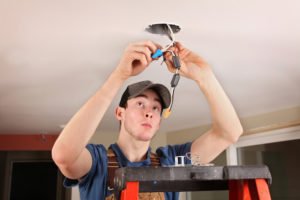Electrical fires are some of the leading causes of residential fires in the United States. Take the following measures to minimize your risks of being part of the statistics.
Don’t Overload Circuits
Electrical circuits have maximum power ratings that they can safely handle. You overload an electrical circuit when you try to draw power beyond the circuit’s limit.
Ordinarily, protective measures in the circuit (such as the circuit breaker) would cut off power in case of circuit overload. However, such protective measures can fail and lead to overheated conductors. The overheating can cause electrical fires in some cases.
Replace Outdated Fixtures
Electrical fixtures and installations age with time, and they become dangerous when they age. For example, the insulation materials of electrical wires deteriorate and crack with time. Without the protective insulation, a short circuit can ensue and trigger a chain of events that ends in an electrical fire. Talk to an electrician to advise you on when to replace your outdated wiring.
Keep Wiring Up to Code
The National Electrical Code, NEC, has a set of standards for the safe installation of electrical wiring and equipment. NEC regularly updates its standards as new information on electrical safety comes to light. These standards, among other things, can help you prevent electrical fires.
For example, NEC requires ground-fault circuit interrupters (GFCIs) for all outdoor outlets. This requirement ensures that a ground fault, such as moisture exposure might cause, doesn’t trigger a serious electrical fault that can cause an electrical fire.
Repair Malfunctions Promptly
Electrical problems usually start small and then blow up into serious issues if you neglect them. Don’t ignore electrical problems even if they seem minor.
For example, a bulb that flickers or dims intermittently may be nothing more than a bother to you. However, the flickers point to underlying problems that need prompt repair. If a bulb flickers because it is loose, for example, the bulb may overheat and trigger fire after some time.
Go Easy on DIY Wiring
Although DIY electrical wiring may save you some money, it might also lead to electrical defects. You can easily make a mistake if you are not a professional electrician. For example, you might use an extremely thin wire that cannot handle the current in a circuit or use an indoor cable for your garden wiring. Such mistakes may trigger electrical fires in some cases.
Only try DIY wiring with simple issues that you have handled in the past. Whenever you are in doubt, trust your instincts and let a professional electrician handle the issue.
Have Regular Inspections
Your electrical wiring is not safe just because you have not noticed an obvious problem or signs of danger. Some electrical faults lurk under the surface and only flare up when another problem occurs.
For example, rusty contacts in an electrical outlet may not be problematic with low-current usage but may cause problems with high-powered devices. You may charge your phone safely from such an outlet, only for it to overheat when you plug in a power tool or blow dryer. Regular inspections (every few years, your electrician will help you specify the intervals) can catch such malfunctions.
Install Protective Devices
Lastly, install protective devices to enhance your electrical safety. For example, a surge protector can protect your house from temporary spikes in electricity. GFCIs can detect leakage in the current and cut off electricity before major damage occurs. Arc-fault circuit interrupters (AFCIs) can detect arc faults and cut off electricity before materials in the circuit overheat.
Hopefully, the above tips will help you minimize the risk of electrical fires in your home. Contact A to Z Electric Co, for professional electrical inspections, repairs, and installations to ensure your home’s electrical wiring is safe.

